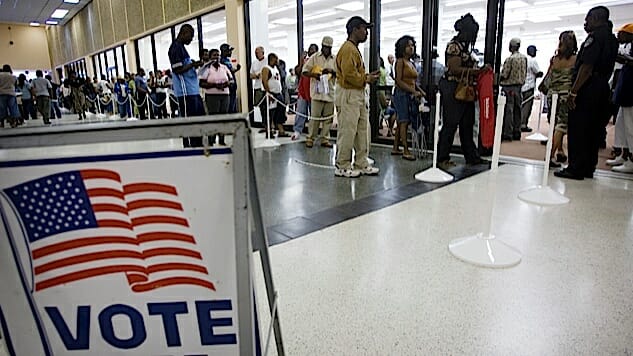There Are Many Reasons to Vote in the Midterms. The Census May Be the Most Important
This is why you need to vote in 2018.
Photo by Zach Boyden-Holmes/Getty
Karl Rove’s March 2010 Wall Street Journal editorial, “The GOP Targets State Legislatures,” may go down as one of the most consequential pieces of political writing of the decade. In it, the Republican strategist laid out a plan to use partisan redistricting after the census to “control Congress” for a “decade to come.” Gerrymandering had already been a longstanding practice in American politics, but Rove hinted at something far more extreme; something game-changing. With another census around the corner in 2020 and an election tomorrow, his essay and the response to it by Democrats bear re-examining.
At the time of its publication, Rove’s editorial was met with little fanfare. Drunk off a landslide win in 2008, Democrats had faith in their newly-elected and wildly popular (not to mention historic) president. Barack Obama had his own plans and they certainly didn’t involve pouring money into what he saw as the unreliable state parties. Instead, he would concentrate power and funds largely in his own shadow party, OFA.
Eight years later, however, the results speak for themselves. Republicans ended up sweeping the 2010 midterms and controlling congressional and state redistricting across the country. Democrats have failed to win a majority in the House of Representatives ever since, and the GOP now controls 26 states entirely and the legislatures in an additional six (67 of 99 legislative chambers nationwide), placing it well within striking distance of the 34-state threshold for calling a constitutional convention and the 38-state threshold for ratifying new amendments.
Yet Democrats still didn’t learn the lesson. In 2016, with the census a presidential term away, the party’s leadership lined up behind, and actively worked to nominate, a historically unpopular candidate. The decision ignored several important factors that perhaps should have been considered: the tendency of voters to reject the president’s party in the midterms, the already unfavorable 2018 election map, and the fact that the last consecutive two-term presidents from the same party were James Madison and James Monroe. But if there were any concerns about what a Hillary presidency would mean for the post-2020 redistricting, they certainly weren’t aired publicly. The DNC even entered into a joint-fundraising agreement with Hillary For America that left the state parties severely underfunded, with all but one percent of the cash going to the Clinton campaign.
Incidentally, Trump’s victory may have temporarily saved the Democrats from themselves, setting up the GOP to take midterm losses in what would otherwise be a favorable year. But even then, the so-called “Blue Wave” everyone and their mother seems to be talking about is hardly a guarantee with Democrats struggling to maintain their edge. The party has held a narrow but consistent lead on the generic ballot, but a recent poll from The Atlantic found that only one in three millennials are definitely planning on voting come November.
-

-

-

-

-

-

-

-

-

-

-

-

-

-

-

-

-

-

-

-

-

-

-

-

-

-

-

-

-

-

-

-

-

-

-

-

-

-

-

-








































